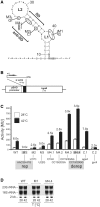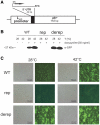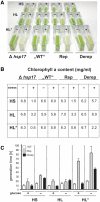Translation on demand by a simple RNA-based thermosensor
- PMID: 21131278
- PMCID: PMC3074152
- DOI: 10.1093/nar/gkq1252
Translation on demand by a simple RNA-based thermosensor
Abstract
Structured RNA regions are important gene control elements in prokaryotes and eukaryotes. Here, we show that the mRNA of a cyanobacterial heat shock gene contains a built-in thermosensor critical for photosynthetic activity under stress conditions. The exceptionally short 5'-untranslated region is comprised of a single hairpin with an internal asymmetric loop. It inhibits translation of the Synechocystis hsp17 transcript at normal growth conditions, permits translation initiation under stress conditions and shuts down Hsp17 production in the recovery phase. Point mutations that stabilized or destabilized the RNA structure deregulated reporter gene expression in vivo and ribosome binding in vitro. Introduction of such point mutations into the Synechocystis genome produced severe phenotypic defects. Reversible formation of the open and closed structure was beneficial for viability, integrity of the photosystem and oxygen evolution. Continuous production of Hsp17 was detrimental when the stress declined indicating that shutting-off heat shock protein production is an important, previously unrecognized function of RNA thermometers. We discovered a simple biosensor that strictly adjusts the cellular level of a molecular chaperone to the physiological need.
Figures









Similar articles
-
Mechanistic insights into temperature-dependent regulation of the simple cyanobacterial hsp17 RNA thermometer at base-pair resolution.Nucleic Acids Res. 2015 Jun 23;43(11):5572-85. doi: 10.1093/nar/gkv414. Epub 2015 May 4. Nucleic Acids Res. 2015. PMID: 25940621 Free PMC article.
-
Translational control of small heat shock genes in mesophilic and thermophilic cyanobacteria by RNA thermometers.RNA Biol. 2014;11(5):594-608. doi: 10.4161/rna.28648. Epub 2014 Apr 2. RNA Biol. 2014. PMID: 24755616 Free PMC article.
-
Short ROSE-like RNA thermometers control IbpA synthesis in Pseudomonas species.PLoS One. 2013 May 31;8(5):e65168. doi: 10.1371/journal.pone.0065168. Print 2013. PLoS One. 2013. PMID: 23741480 Free PMC article.
-
Translation initiation and the fate of bacterial mRNAs.FEMS Microbiol Rev. 2006 Nov;30(6):967-79. doi: 10.1111/j.1574-6976.2006.00043.x. Epub 2006 Sep 21. FEMS Microbiol Rev. 2006. PMID: 16989654 Review.
-
Temperature-controlled molecular switches in mammalian cells.J Biol Chem. 2024 Nov;300(11):107865. doi: 10.1016/j.jbc.2024.107865. Epub 2024 Oct 5. J Biol Chem. 2024. PMID: 39374780 Free PMC article. Review.
Cited by
-
Interactions between SAM and the 5' UTR mRNA of the sam1 gene regulate translation in S. pombe.RNA. 2020 Feb;26(2):150-161. doi: 10.1261/rna.072983.119. Epub 2019 Nov 25. RNA. 2020. PMID: 31767786 Free PMC article.
-
RNA thermometer controls temperature-dependent virulence factor expression in Vibrio cholerae.Proc Natl Acad Sci U S A. 2014 Sep 30;111(39):14241-6. doi: 10.1073/pnas.1411570111. Epub 2014 Sep 16. Proc Natl Acad Sci U S A. 2014. PMID: 25228776 Free PMC article.
-
RNA-based thermoregulation of a Campylobacter jejuni zinc resistance determinant.PLoS Pathog. 2020 Oct 16;16(10):e1009008. doi: 10.1371/journal.ppat.1009008. eCollection 2020 Oct. PLoS Pathog. 2020. PMID: 33064782 Free PMC article.
-
In vivo RNA structural probing of uracil and guanine base-pairing by 1-ethyl-3-(3-dimethylaminopropyl)carbodiimide (EDC).RNA. 2019 Jan;25(1):147-157. doi: 10.1261/rna.067868.118. Epub 2018 Oct 19. RNA. 2019. PMID: 30341176 Free PMC article.
-
The Role of RNA Secondary Structure in Regulation of Gene Expression in Bacteria.Int J Mol Sci. 2021 Jul 22;22(15):7845. doi: 10.3390/ijms22157845. Int J Mol Sci. 2021. PMID: 34360611 Free PMC article. Review.
References
-
- Castielli O, De la Cerda B, Navarro JA, Hervas M, De la Rosa MA. Proteomic analyses of the response of cyanobacteria to different stress conditions. FEBS Lett. 2009;583:1753–1758. - PubMed
-
- Latifi A, Ruiz M, Zhang CC. Oxidative stress in cyanobacteria. FEMS Microbiol. Rev. 2009;33:258–278. - PubMed
-
- Lee S, Prochaska DJ, Fang F, Barnum SR. A 16.6-kilodalton protein in the Cyanobacterium Synechocystis sp. PCC 6803 plays a role in the heat shock response. Curr. Microbiol. 1998;37:403–407. - PubMed
Publication types
MeSH terms
Substances
LinkOut - more resources
Full Text Sources
Other Literature Sources
Molecular Biology Databases

